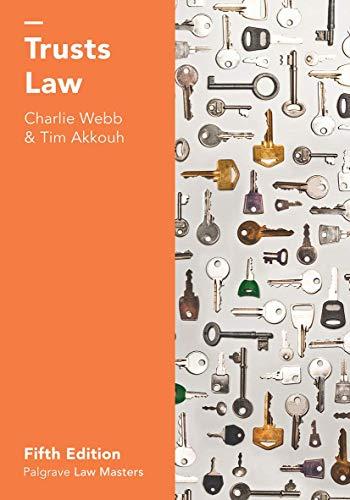Question
Nelson v. Marchi https://www.canlii.org/en/ca/scc/doc/2021/2021scc41/2021scc41.html Use the case above to answering the following questions below: 11) When the duty of care at issue can be described
Nelson v. Marchi
https://www.canlii.org/en/ca/scc/doc/2021/2021scc41/2021scc41.html
Use the case above to answering the following questions below:
11) When the duty of care at issue can be described as this, there is generally no need to proceed through the full two-stage Anns/Cooper framework because over the years, courts in Canada have developed a body of negligence law recognizing categories of cases in which a duty of care has previously been established.
a) vexatious
b) not novel
c) novel
d) frivolous
12) A duty of care is firmly established in Canadian law. Over a decade later in Cooper, when this Court gave examples of categories in which proximity had previously been recognized, it specifically observed: ". . . governmental authorities who have undertaken a policy of road maintenance have been held to owe a duty of care to execute the maintenance in" this manner:
a) with utmost care
b) a careful and prudent manner
c) a haphazard manner
d) a non-negligent manner
13) The duty of care for the municipality also clearly extends to the prevention of injuries from snowbanks created by a government defendant on the road and sidewalk. In the view of the SCC, Ms. Marchi has proved that her circumstances fall within the scope of the Just category. As discussed below, it remains open to the City to prove this as a defense to the claim of negligence:
A) the City to prove that there was no foreseeability or proximity
B) the City to prove that there are policy consideration voiding negligence
C) the City to prove that the relevant government decision was a core policy decision immune from liability in negligence.
D) the City to prove that operational decisions resulted in the condition that caused the incident
14) Thus, four factors emerge from this Court's jurisprudence that help in assessing the nature of a government's decision qualifies as a core policy decision including all of the following except:
a) the process by which the decision was made
b) the lack of budgetary consideration
c) the level and responsibilities of the decision-maker
d) the extent to which the decision was based on objective criteria.
15) Because the City has not shown that the decisions leading to the creation of the snowbank associated with Ms. Marchi's fall were not core policy decisions, the City owes Ms. Marchi this:
a) causation
b) the obligation to act as her insurer for any injury sustained
c) one million dollars
d) a duty of care
16) After determining its decision on the issue of whether the City owes Ms. Marchi a duty of care, the court then turns to consider these remaining two issues:
a) standard of care and causation.
b) correctness and palpable and overriding error
c) volenti non fit injuria and res judicata
d) quantum of damages and contributory negligence
17) To avoid liability, a defendant must "exercise the standard of care expected that would be of an ordinary, reasonable and prudent person in the same circumstances" Relevant factors in this assessment include all of the following except:
a) whether the risk of injury was reasonably foreseeable
b) the severity of injuries sustained
c) the likelihood of damage
d) the availability and cost of preventative measures
18) It is well established that a defendant is not liable in negligence unless their breach caused the plaintiff's loss. First, the defendant's breach must be the factual cause of the plaintiff's loss. Factual causation is generally assessed using this test:
a) a balance of probabilities
b) The "but for" test
c) causation on the basis of scientific certainty
d) the material contribution test
19) Second in terms of causation, the breach must be the legal cause of the loss, meaning that the harm must not be too far remote. The remoteness inquiry asks whether the actual injury was the reasonably foreseeable result of the defendant's negligent conduct. The SCC found that the trial judge erred by conflating causation with this:
a) standard of care
b) duty of care
c) voluntary assumption of risk
d) quantum of damages
20) The trial judge appears to have misapplied the defence of contributory negligence. Under provincial statutes such as British Columbia's Negligence Act, R.S.B.C. 1996, c. 333, contributory negligence is no longer this:
a) a determinative factor
b) relevant
c) a complete bar to recovery
d) a voluntary assumption of risk
Step by Step Solution
There are 3 Steps involved in it
Step: 1

Get Instant Access to Expert-Tailored Solutions
See step-by-step solutions with expert insights and AI powered tools for academic success
Step: 2

Step: 3

Ace Your Homework with AI
Get the answers you need in no time with our AI-driven, step-by-step assistance
Get Started


